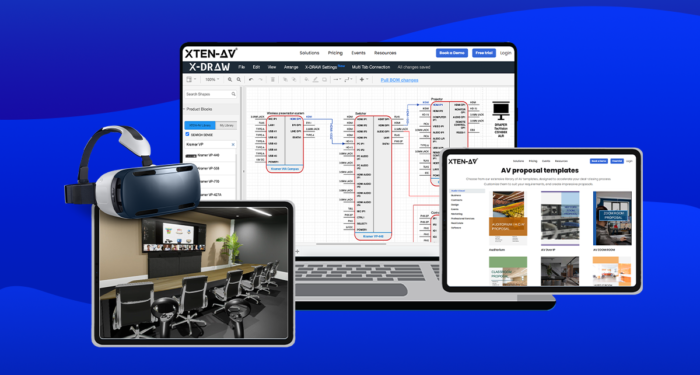With the development of technology in the field of audio visual there is a constant process of selecting the right design software, especially in the audio and video field. Choosing the right AV design software can be a daunting task since some people don’t know what to start with there are many programs available in the market. This work will help to make the exploration wiser and find the program that best fits the needs of the user.
Establishing an incredible and awe-inspiring audiovisual experience needs proper planning and the right software as an integrator, consultant, or enthusiast. The quality of software greatly affects the quality of work and time efficiency.
Understanding the Landscape of AV Design Software
Understanding the different audio visual drawing & design software categories and features is crucial before beginning the selection process. These free av design software cover a broad spectrum of functions, including project management, equipment selection, signal flow diagrams, and 3D modeling and simulation.
- 3D Modeling and Simulation: By utilizing the 3D modeling features frequently included in AV design software, you can generate intricate virtual representations of your project areas. These tools can also run simulations to improve lighting, acoustics, and overall system performance and visualize equipment location and cable routing.
- Equipment Selection and Sizing: Many AV design software products include capabilities that help with the selection and sizing of audiovisual equipment. These tools recommend appropriate equipment based on variables such as room dimensions, audience capacity, and desired performance criteria.
- Signal Flow Diagrams: In AV design, it is essential to visualize and record the flow of audio and video information. Creating signal flow diagrams is made easier with software tools that map out system connections, spot any bottlenecks, and expedite troubleshooting procedures.
- Project Management: Certain AV design software includes project management tools in addition to aspects unique to designs. These tools allow you to assign resources, plan and organize project stages, keep track of milestones, and promote cooperation between stakeholders and team members.
Assessing Your Needs and Requirements
It is imperative that you perform a thorough study of your particular needs and project specifications before beginning the software selection process. Consider the following components:
- Project Scope and Complexity: Analyze the scope and difficulty of your usual audio visual projects. Do you mostly work on large-scale, multi-room projects or small-scale installations? The amount of functionality and scalability your software needs will depend on the size of your projects.
- Design Workflows: Examine your current design processes to find places where digital tools could improve accuracy and productivity. Is a more straightforward 2D layout adequate, or do you need more sophisticated 3D modeling capabilities? Do you place more emphasis on visual and lighting design than on acoustics and audio simulations?
- Collaboration and Integration: Determine whether it’s required to collaborate with outside parties, such as consultants, architects, or contractors. If so, look for software that enables smooth integration and cross-platform file sharing.
- Budget Considerations: While high-end AV design software might have many features, the cost is usually greater. When choosing software solutions, assess your financial limits and consider the long-term return on investment.
Key Features to Consider in AV Design Software
Take into account the following essential functions and features while assessing possible AV design software options:
- 3D Modeling and Visualization: Seek for programs with sophisticated 3D modeling and rendering features. This tool allows you to generate comprehensive virtual representations of your project locations, which is very useful for complicated and large-scale installations.
- Acoustics and Audio Simulations: Software with sophisticated acoustics modeling capabilities should be given priority if audio quality is important to you and your projects. You may minimize possible acoustic problems, plan speaker placement, and forecast sound dispersion with the use of these tools.
- Video and Lighting Simulations: For projects that involve video displays, projectors, or intricate lighting setups, seek software that offers video and lighting simulations. These features allow you to visualize and fine-tune the visual aspects of your designs.
- Equipment Libraries and Selection Tools: Look for software that includes comprehensive libraries of audiovisual equipment from various manufacturers. This feature streamlines the equipment selection process and ensures accurate sizing and compatibility checks.
- Signal Flow Diagramming: Robust signal flow diagramming capabilities are essential for documenting system connectivity, troubleshooting, and ensuring seamless integration of various components.
- Integration with Other Software: Consider software that integrates seamlessly with other tools you may use, such as CAD software, project management platforms, or building information modeling (BIM) solutions. Seamless integration can significantly enhance workflow efficiency and collaboration.
- User Interface and Ease of Use: Evaluate the user interface and overall usability of the software. A well-designed interface can greatly impact your productivity and learning curve, especially for complex projects or when working with teams.
- Training and Support: Assess the availability of training resources, documentation, and support options provided by the software vendor. Adequate training and support can ensure a smoother transition and maximize the software’s potential.
Top AV Design Software Options
While the market offers a wide array of options, here are some of the top free AV design software solutions to consider:
- EASE (Enhanced Acoustic Simulator for Engineers): Developed by Afmg Technologies, EASE is a powerful software suite specifically designed for acoustic simulations and audio system design. It offers advanced tools for room acoustics modeling, speaker placement optimization, and audio system performance predictions.
- AutoCAD: While not specifically designed for AV applications, AutoCAD is a widely used CAD software that can be leveraged for AV design tasks. It offers robust 2D and 3D modeling capabilities, as well as integration with various AV-specific plugins and third-party tools.
- Revit: Developed by Autodesk, Revit is a Building Information Modeling (BIM) software that has gained popularity in the AV industry. It offers 3D modeling capabilities, integration with other Autodesk products, and the ability to incorporate AV system data into building models.
- D-Tools System Integrator: D-Tools SI is a comprehensive software solution designed specifically for AV system integrators. It offers project management, system design, proposal generation, and documentation capabilities, all within a unified platform.
- SoundVision: Developed by Bose Professional, SoundVision is a software suite focused on acoustics simulations and audio system design. It offers tools for room modeling, speaker positioning, and system optimization, catering to both commercial and residential audio projects.
- Vectorworks Spotlight: Part of the Vectorworks suite, Spotlight is a specialized software for entertainment design, including lighting, audio, and video system design. It offers 3D modeling, documentation tools, and integration with other Vectorworks products.
- SketchUp: While not exclusively designed for AV applications, SketchUp is a popular 3D modeling software that can be utilized for AV design tasks. Its user-friendly interface and extensive library of plugins make it a versatile option for visualizing AV system layouts.
- X-DRAW: X-draw is an easy-to-use audio visual design software that offers sophisticated features for audiovisual systems, such as real-time audio simulation, speaker placement optimization, and room layout planning. It smoothly combines with other audio visual equipment, enabling users to efficiently work together and optimize their design process. For experts in the audio visual sector looking for immersive, superior audiovisual experiences, X-draw is a great option.
Evaluating and Selecting the Right Audio Visual Design Software
Once you’ve identified potential software options that align with your needs and requirements, it’s crucial to conduct thorough evaluations and comparisons. Consider the following steps:
- Request Demonstrations and Trials: The majority of software providers provide demos or trial versions of their products. Make the most of these chances to obtain practical experience and evaluate the software’s capabilities directly.
- Evaluate User Reviews and Testimonials: Examine case studies, user evaluations, and endorsements from AV industry experts. These observations can offer insightful viewpoints on the software’s advantages, disadvantages, and practical performance.
- Assess Training and Support Resources: Evaluate the availability and quality of training resources, documentation, and customer support offered by the software vendor. Adequate support can greatly facilitate the learning process and ensure efficient software utilization.
- Consider Integration and Compatibility: If you rely on other software tools or platforms, assess the compatibility and integration capabilities of the AV design software with your existing ecosystem. Seamless integration can streamline workflows and enhance productivity.
- Analyze Long-Term Costs and Scalability: While the initial purchase cost is important, consider the long-term costs associated with software updates, maintenance fees, and potential scaling requirements as your business grows.
- Seek Industry Recommendations and Insights: Leverage your professional network and industry associations to gather recommendations and insights from experienced AV professionals. Their firsthand experiences can provide valuable guidance in the software selection process.
Conclusion
Ultimately, the choice of software has a substantial influence on the quality of experiences one can create. Given the diversity of available options, understanding the landscape of various AV design software categories and features is crucial for making an optimal decision. By taking into account one’s needs, the complexity of the projects one will work on, and his or her budget, people may find a software solution that perfectly fits their workflow. Whether it is the advanced 3D modeling, accurate acoustics simulation, or integration capabilities, leading AV design software has a lot to offer to enhance efficiency and creativity. By carefully assessing the available options, using various tools for comparison, checking the assessment of thousands of users, and predicting one’s future needs and budget, one can find software that will help make their designs stand out and create exceptional experiences.
Frequently Asked Questions
How can I decide which AV design software is the most appropriate for my projects?
It is really important to analyze your project’s size, difficulty, and other unique factors. Moreover, it can be required to pay attention to whether or not you need 3D modeling, acoustics preparation, integrations, and how much money you have.
Are there any resources available for training and support when using AV design software?
Many software vendors offer comprehensive training resources, documentation, and customer support to facilitate the learning process and ensure efficient utilization of their products. Utilize these resources to enhance your proficiency and troubleshoot any issues that may arise.
Can AV design software integrate with other tools or platforms?
Yes, integration capabilities vary among different AV design software options. To streamline workflows and enhance collaboration, it’s important to assess compatibility with your existing ecosystem, including CAD software, project management platforms, and BIM solutions.












































































